Royal Gorge Route Railroad
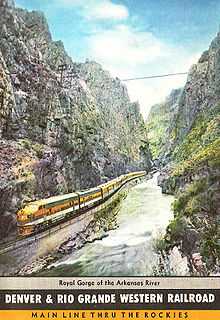
The Royal Gorge Route Railroad is a heritage railroad located in Cañon City, Colorado. The railroad transits the Royal Gorge on a 2-hour scenic and historic train ride along what is considered to be the most famed portion of the former Denver and Rio Grande Western Railroad. The 1950s-era train departs the Santa Fe Depot in Cañon City daily.
History
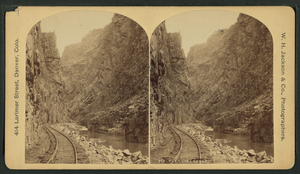
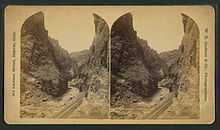
In the late 1870s, miners descended on the upper Arkansas River valley of Colorado in search of carbonate ores rich in lead and silver. The feverish mining activity in what would become the Leadville district attracted the attention of both the Rio Grande and Santa Fe railroads, each already having tracks in the Arkansas valley. The Santa Fe had tracks in Pueblo and the D&RGW had tracks near Canon City, Colorado, some 35 miles west. Leadville was over 100 miles away. For two railroads to occupy a river valley ordinarily was not a problem, however, west of Canon City the Arkansas River cuts through a high plateau of igneous rocks forming a spectacular steep-walled gorge over a thousand feet deep. At its narrowest point sheer walls on both sides plunge into the river, creating an impassable barrier.[1] Sharing is not an option along this route.
On April 19, 1878, a hastily assembled construction crew from the Santa Fe began grading for a railroad line just west of Cañon City in the mouth of the gorge. Rio Grande, whose track ended only ¾ of a mile from Cañon City, raced crews to the same area, but they were blocked by Santa Fe graders in the narrow canyon. By a few hours they had lost the first round in what became a two-year struggle between the two railroads that would be known as the Royal Gorge War.[1]
The Royal Gorge War
Rio Grande crews tried leapfrogging Santa Fe grading crews, but were met with court injunctions from the Santa Fe in the contest for the right-of-way. Rio Grande crews then built several stone "forts" (such as Fort DeRemer at Texas Creek) upstream in an attempt to block Santa Fe work. Grading crews were harassed by rocks rolled down on them, tools thrown in the river and other acts of sabotage. Both sides hired armed guards for their crews.
While lawyers argued both sides in court, armed men hired by Santa Fe took control of Rio Grande stations from Denver to Cañon City. They hired Bat Masterson, a sheriff in Ford County, Kansas at the time, to assemble a group of men to defend their interests. Masterson enlisted the help of Doc Holliday to find recruits. Among the sixty or so hired were two gunfighters with the colorful names of “Dirty” Dave Rudabaugh and “Mysterious” Dave Mather. The group held the key position of defense at the Santa Fe roundhouse in Pueblo.
In June 1879, R.F. Weitbrec, treasurer of Rio Grande, suggested to Sheriff Henly R. Price, and his deputy, that they “borrow” the cannon from the state armory as a way to drive Masterson and his men from the roundhouse. To their surprise, the group found that Masterson had already “borrowed” the cannon and had it at the roundhouse trained on the line of attackers.[2]
Weitbrec assembled a group of gunmen. They stormed the telegraph office on the railroad platform and drove the defenders out the back windows, where, it is said, Harris W Jenkins, the only casualty of the war, was shot in the back by a drunken Rio Grande guard. He was returned to his home in Pawnee County, Kansas where lay paralyzed, and eventually died of his injury, one day short of his 30th birthday. Facing the re-borrowed cannon, Masterson's men surrendered the round house. After a long legal battle that ended in the U.S. Supreme Court, on April 21, 1879, the D&RG was granted the primary right to build through the gorge that in places was wide enough for only one railroad at most.[3]
After the Royal Gorge War
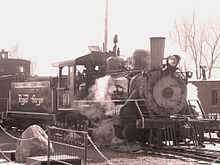
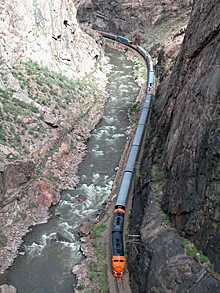
Santa Fe resorted to its larger corporate power and announced it would build tracks parallel to and in competition with the existing D&RG lines. The bondholders of the D&RGW, fearing financial ruin from this threat, pressured the management of the D&RGW to lease the existing railroad to the Santa Fe for a 30-year period. This created a short-lived truce in the struggle. The Santa Fe soon manipulated freight rates south of Denver to favor shippers from Kansas City (over its lines to the east) to the detriment of Denver merchants and traffic over the leased D&RGW lines. During this period, Santa Fe constructed the railroad through the gorge itself. Rio Grande, however, continued construction in areas west of the gorge still trying to block Santa Fe work.
After months of shrinking earnings from their leased railroad, Rio Grande management went to court to break the lease. An injunction from a local court restraining Santa Fe from operating Rio Grande trackage on June 10, 1879, sparked an armed retaking of their railroad by Rio Grande crews. Trains were commandeered, depots and engine houses put under siege, bullets flew and a few men died. A final peace in the war came after the intervention of the Federal courts and the railroad "robber baron" Jay Gould, who loaned the D&RG $400,000 and announced the intention to complete a rail line in competition to the Santa Fe from St. Louis to Pueblo.
On March 27, 1880, the two railroads signed what was called the Treaty of Boston which settled all litigation, and gave the D&RG back its railroad. The D&RG paid the Santa Fe $1.8 million for the railroad it had built in the gorge, the grading it had completed, materials on hand, and interest. D&RG construction resumed, and rails reached Leadville on July 20, 1880. Passenger train service began in 1880 and continued through 1967. Rio Grande continued freight service through the gorge as part of their Tennessee Pass subdivision until 1989, when the company merged with the Southern Pacific Railroad, and the Southern Pacific name took control of the gorge line. In 1996, the combined company was merged into the systems of the Union Pacific Railroad. The year after Union Pacific purchased Southern Pacific and Rio Grande, the railroad closed the Tennessee Pass line, including the gorge segment.
In 1998, Union Pacific Railroad was persuaded to sell the 12 miles of track through the Royal Gorge in an effort to preserve this scenic route. Two new corporations, the Cañon City & Royal Gorge Railroad (CC&RG) and Rock & Rail, Inc. (R&R), joined together to form Royal Gorge Express, LLC (RGX) to purchase the line. Passenger service on the new Royal Gorge Route Railroad began in May 1999. Train movements are still controlled by the Union Pacific’s Harriman Dispatching Center in Omaha, Nebraska. Except for this section of track, the Tennessee Pass line remains dormant.[3]
Hanging Bridge
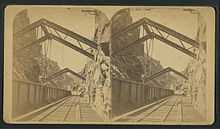
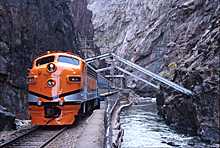
A highlight of the gorge route is the 1879 hanging bridge located along the north side where the gorge narrows to 30 feet (9.1 m) and the sheer rocks walls plunge into the river. Designed by Kansas engineer C. Shallor Smith and built for $11,759, the bridge consists of a 175-foot (53 m) plate girder suspended on one side under A-frame girders that span the river and are anchored to the rock walls. Strengthened over the years, the bridge remains in service today.[3]
Royal Gorge Route Today
The Royal Gorge Route Railroad operates trains year-round through the Royal Gorge from Cañon City, Colorado to the western terminus in Parkdale, Colorado. The train is a destination attraction that carries passengers under the Royal Gorge suspension bridge.[4]
See also
References
^ Osterwald, Doris (2003). Rails Thru the Gorge. Hugo: Western Guideways, Ltd. ISBN 0-931788-15-3.
- ↑ 1.0 1.1 http://www.nps.gov/history/history/online_books/blm/co/17/chap9.htm
- ↑ http://cozine.com/2011-january/the-%E2%80%9Cwar%E2%80%9D-for-the-royal-gorge/
- ↑ 3.0 3.1 3.2 Osterwald, Doris (2003). Rails Thru the Gorge. Hugo: Western Guideways, Ltd. ISBN 0-931788-15-3.
- ↑ http://cozine.com/1998-december/royal-gorge-rr-plans-to-run-next-spring/
External links
| Wikimedia Commons has media related to Royal Gorge Route Railroad. |
Coordinates: 38°26′17″N 105°14′26″W / 38.43798°N 105.24056°W